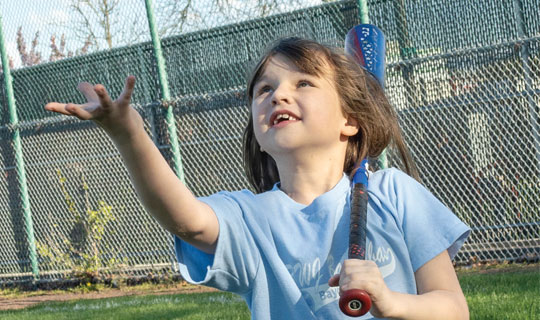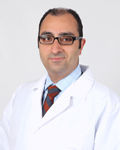After open heart surgery, 7-year-old Lily's biggest concern was the availability of blue ice pops and the unpleasant taste of acetaminophen. “Considering that she had open heart surgery, I'll take those complaints any day!” said her mother, Denise.

How an expert team of pediatric specialists caught an active girl's heart defect.
In many ways, Lily Diver is a typical 9-year-old. She plays softball and basketball, and cheers with a local cheer gym. “She also loves skin care, Stanley cups and Taylor Swift,” says her mom, Denise Leonard. The youngest of three children, Lily will be in third grade at William Shemin Midtown Community School in Bayonne, where she lives with Denise, a teacher at the school.
What is not typical about Lily: She was born with a critical heart defect.
Although she had lived with the condition her whole life, she and her mother only found out about it in February. That’s when Lily was diagnosed with coarctation of the aorta by Donald C. Putman, MD, Division Chief, Pediatric Cardiology, at Cooperman Barnabas Medical Center—part of the Children’s Health network at RWJBarnabas Health—and a member of RWJBarnabas Health Medical Group.

Coarctation is a narrowing of the aorta, the main artery that carries blood from the heart to the rest of the body. The congenital (present at birth) condition forces the heart to pump harder to move blood.
While the narrowed artery can cause problems including chest pain, headaches, high blood pressure and shortness of breath, no symptoms ever stood out to Denise.
Alert Doctors
Denise and Lily discovered that something was amiss almost by happenstance.
In October 2023, Denise took Lily for a flu shot. During the routine appointment, Vincent Serafino, MD, a pediatrician at Jersey City Medical Center, noticed a heart murmur. Knowing that Denise had recently undergone heart surgery for a congenital valve condition, Dr. Serafino suggested that she take Lily to a pediatric cardiologist as a precaution.
Denise was referred to Dr. Putman, who conducted a thorough exam and several tests. He noted telltale discrepancies in Lily’s blood pressure and pulse. “The blood pressure in Lily’s right arm was 148 over 85, which is high even for an adult,” says Dr. Putman. “However, the blood pressure in her left leg was 105 over 78.” Such a mismatch is a classic indicator of aortic coarctation.
“Dr. Putman was very surprised that Lily wasn’t experiencing any symptoms and was as active as she is,” says Denise.
Now clued in to a potential problem, Denise realized in retrospect that Lily had in fact experienced headaches. “I attributed them to allergies or not wanting to go to school,” Denise says. In reality, Lily’s coarctation had caused severe high blood pressure that triggered head pain.
Dr. Putman ordered an electrocardiogram (EKG) and an echocardiogram, or ultrasound of the heart. He also referred Lily to the Children’s Heart Center at Children’s Hospital of New Jersey (CHoNJ)—part of a program at Newark Beth Israel Medical Center for treating congenital heart disease in infants, children and adults.

At CHoNJ, Mark Michael, DO, a pediatric cardiologist and a member of RWJBarnabas Health Medical Group, performed a cardiac CT scan.
The imaging not only confirmed the diagnosis but also provided important details. Lily’s defect was a particularly long form known as long-segment coarctation. What’s more, the arch where the aorta curves like a candy cane to deliver blood to the body was underdeveloped—a condition known as aortic arch hypoplasia.
Denise consulted Rajiv Verma, MD, Director of the Children’s Heart Center, to discuss the findings and options for next steps. Lily was in urgent need of treatment. But Dr. Verma, cardiac surgeon Emile A. Bacha, MD, and their team had to weigh the merits of different approaches carefully.
Playing the Long Game

One option was to use a catheter, or tube, to reach the coarctation through blood vessels and open the narrowed passage with a balloon or stent. This minimally invasive approach, known as angioplasty, is often recommended for long-segment coarctation because it does not involve cutting the chest and recovery is relatively fast.
But a child like Lily would eventually outgrow a stent, so it later would need to be revised. “Lily was too young for a definitive transcatheter-based procedure, and her aortic arch was small,” Dr. Bacha says.
The team looked to surgery as a more viable option. “Though surgery is technically challenging for a long-segment coarctation, the likelihood of Lily ever needing another procedure would be small,” Dr. Verma says.
Dr. Verma explained the pros and cons to Denise. “I opted for open heart surgery because it was a fix rather than a Band-Aid,” she says. “I felt that the more we can do now, the better for Lily in the long term.”
On March 8, Dr. Bacha performed Lily’s four-hour surgery, repairing the aortic coarctation and reconstructing the arch by removing the narrowest portion and augmenting the entire arch with a patch.
Lily took it all in stride, asking Dr. Bacha before surgery if she could play in a championship basketball game that night. (“Let’s see how you feel first,” he said.)
“She was a star patient and handled everything like a champ,” says Kelly Thibault, RN, MSN, CPNP, a nurse practitioner in pediatric cardiac surgery who cared for Lily from diagnosis through recovery.
While she was hospitalized, Lily’s biggest concerns were matters like the availability of blue ice pops and the unpleasant taste of pain-relieving acetaminophen. “Considering that she had open heart surgery, I’ll take those complaints any day!” Denise says.
Lily will need to see a cardiologist for the rest of her life, Dr. Verma says, but restrictions on her activity were short-term. She should be able to fully participate in sports this school year.
Comprehensive Cardiac Care for Kids
Children’s Hospital of New Jersey (CHoNJ) is New Jersey’s most comprehensive pediatric cardiac surgery center and draws patients from throughout the state and beyond.
RWJBarnabas Health also offers extensive pediatric cardiology services at the Anne Vogel Family Care and Wellness Center, part of The Unterberg Children’s Hospital at Monmouth Medical Center; the Pediatric Specialty Center at Cooperman Barnabas Medical Center; and The Bristol-Myers Squibb Children’s Hospital (BMSCH) at Robert Wood Johnson University Hospital in New Brunswick.
Advanced cardiac services for children available at both CHoNJ and BMSCH include lifesaving technologies such as pediatric extracorporeal membrane oxygenation (ECMO), a critical form of life support. The programs together offer care for a wide range of heart issues in children, including valve conditions, structural defects, arrhythmias, heart failure, tumors and sudden cardiac arrest.
Learn more about Children's Health Network at RWJBarnabas Health.
 View full issues of Healthy Together magazine by New Jersey region:
View full issues of Healthy Together magazine by New Jersey region: